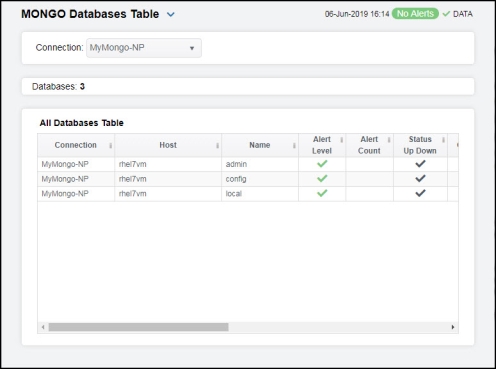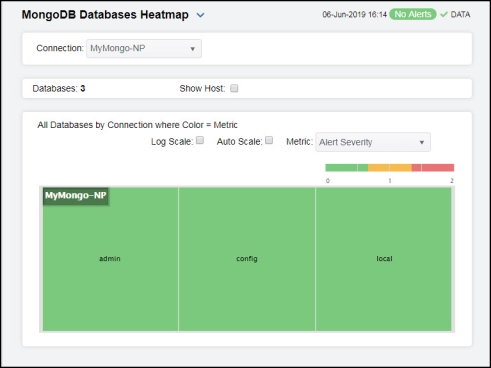Mongo Databases View
These displays present detailed performance metrics and alert statuses for all databases (in a heatmap or a tabular format) or for an individual database. Clicking Mongo Databases from the left/navigation menu opens the MongoDB Databases Table display, which shows a tabular view of all databases their associated metrics.The following displays are available:
| • | All Databases Heatmap: Opens the MongoDB Databases Heatmap display, which shows status and alerts for all MongoDB databases in a heatmap format. |
| • | Single Database Summary: Opens the MongoDB Single Database Summary display, which enables you to view available utilization metrics for a single MongoDB database. |
Note: No database information will display in the heatmap, table, or summary displays if a connection cannot be established.
MongoDB Databases Table
View details for all databases in a single server. Each row in the table contains data for a particular database. Click a column header to sort column data in numerical or alphabetical order. Double-click on a table row to drill-down to the MongoDB Single Database Summary display and view metrics for that particular database. Toggle between the commonly accessed displays by clicking the drop down list on the display title.

MongoDB Databases Heatmap
Clicking All Databases Heatmap in the left/navigation menu opens the MongoDB Databases Heatmap, which provides an easy-to-view interface that allows you to track utilization and performance metrics for all databases in a heatmap format. Use the Metric drop-down menu to view the heatmap using the alert severity, alert count, collections, or data size metrics.
The heatmap is organized by host, each rectangle representing a database. The rectangle color indicates the most critical alert state. Click on a node to drill-down to the MongoDB Single Database Summary display and view metrics for a particular database.
You can select the Show Host check box to display name of the host in each rectangle. You can toggle between the commonly accessed displays by clicking the drop down list on the display title. Mouse-over rectangles to view more details about host performance and status.

|
Available Metrics |
|||
|
|
Select the metric driving the heatmap display. The default is Alert Severity. Each Metric has a color gradient bar that maps values to colors. The heatmap organizes the databases by connection, where each rectangle represents a database. Mouse-over any rectangle to display the current values of the metrics for the database. Click on a rectangle to drill-down to the associated MongoDB Single Database Summary display for a detailed view of metrics for that particular database. |
||
|
|
Alert Severity |
The maximum alert level in the item (index) associated with the rectangle. Values range from 0 to 2, as indicated in the color gradient bar 2 -- Metrics that have exceeded their specified ALARMLEVEL threshold and have an Alert Severity value of 2 are shown in red. For a given rectangle, this indicates that one or more metrics have exceeded their alarm threshold. 1 -- Metrics that have exceeded their specified WARNINGLEVEL threshold and have an Alert Severity value of 1 are shown in yellow. For a given rectangle, this indicates that one or more metrics have exceeded their warning threshold. 0 -- Metrics that have not exceeded either specified threshold have an Alert Severity value of 0 and are shown in green. For a given rectangle, this indicates that no metrics have exceeded a specified alert threshold. |
|
|
|
Alert Count |
The total number of alarm and warning alerts in a given item (index) associated with the rectangle. The color gradient bar |
|
|
|
Collections |
The total number of collections in a given item (index) associated with the rectangle. The color gradient bar The Auto Scale option does not impact this metric. |
|
|
|
Data Size |
The total size (in bytes) of the data in a given item (index) associated with the rectangle. The color gradient bar When Auto Scale is checked, the numeric values in the color gradient bar show the range of the data being displayed rather than the default values. The middle value changes accordingly to indicate the color of the middle value of the range. |
|
MongoDB Single Database Summary
Clicking Single Database Summary in the left/navigation menu opens the MongoDB Database Summary display, which allows you to view utilization, performance, and trend data for a specific database. Clicking on the information boxes at the top of the display takes you to the MongoDB Databases Table display, where you can view additional database data.
The Performance Trends trend graph allows you to view trend data for the collections, index size, storage size, and data size over a selected time range.
Clicking the Critical/Warning link at the bottom of the display opens the Alerts Table by Component display.

 , where
, where  shows the range of the value/color mapping. The numerical values in the gradient bar range from
shows the range of the value/color mapping. The numerical values in the gradient bar range from  shows the range of the value/color mapping. The numerical values in the gradient bar range from
shows the range of the value/color mapping. The numerical values in the gradient bar range from  shows the range of the value/color mapping. By default, the numerical values in the gradient bar range from
shows the range of the value/color mapping. By default, the numerical values in the gradient bar range from